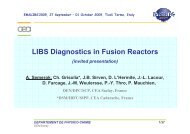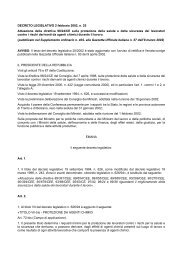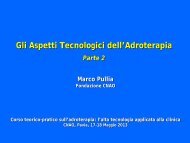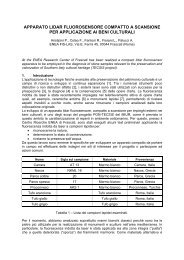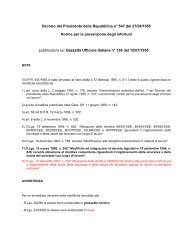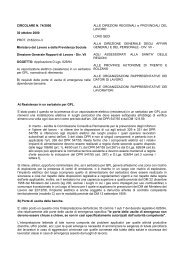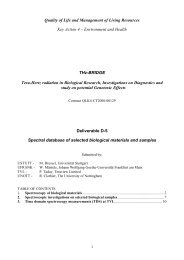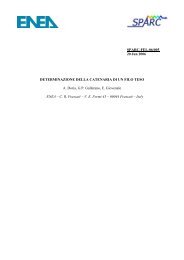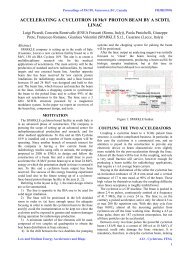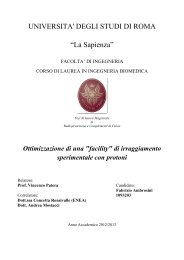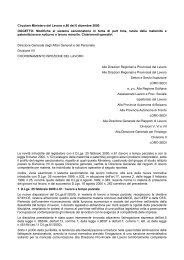Theory, Design and Tests on a Prototype Module of a Compact ...
Theory, Design and Tests on a Prototype Module of a Compact ...
Theory, Design and Tests on a Prototype Module of a Compact ...
Create successful ePaper yourself
Turn your PDF publications into a flip-book with our unique Google optimized e-Paper software.
16 2. LINAC AND SCL ACCELERATORS<br />
f [GHz]<br />
3.08<br />
3.06<br />
3.04<br />
3.02<br />
3<br />
2.98<br />
2.96<br />
2.94<br />
f<br />
ac<br />
f<br />
cc<br />
2.92<br />
0 0.2 0.4 0.6 0.8 1<br />
φ/π<br />
f [GHz]<br />
3.1<br />
3.08<br />
3.06<br />
3.04<br />
3.02<br />
3<br />
2.98<br />
2.96<br />
f<br />
ac<br />
f<br />
cc<br />
2.94<br />
0 0.2 0.4 0.6 0.8 1<br />
φ/π<br />
Figure 2.9. The dispersi<strong>on</strong> diagrams in the case <strong>of</strong> a<br />
biperiodic structure with fa = 3 GHz, fc = 3 GHz,<br />
k = 0.04, k2 = 0.005 <str<strong>on</strong>g>and</str<strong>on</strong>g> k3 = 0 <strong>on</strong> the left <str<strong>on</strong>g>and</str<strong>on</strong>g><br />
fc = fa/ √ 1 − k2 <strong>on</strong> the right.<br />
fa; the total number <strong>of</strong> cavities is therefore 4N + 1. The coupling<br />
between accelerating <str<strong>on</strong>g>and</str<strong>on</strong>g> coupling cavities is k, between n<strong>on</strong>-adjacent<br />
accelerating cells is k2, <str<strong>on</strong>g>and</str<strong>on</strong>g> between coupling cells is k3. With the<br />
hypothesis <strong>of</strong> infinite quality factor, the dispersi<strong>on</strong> formula is [14]<br />
k 2 cos 2 <br />
φ = 1 − f 2 a<br />
f 2 <br />
+ k2 cos 2φ 1 −<br />
q<br />
f 2 c<br />
f 2 <br />
+ k3 cos 2φ , (2.8)<br />
q<br />
where φ is the phase advance. In the previous secti<strong>on</strong> we saw that<br />
for a finite structure the phase advance can assume <strong>on</strong>ly a finite set<br />
<strong>of</strong> value, the number <strong>of</strong> which is equal to the number <strong>of</strong> res<strong>on</strong>ators.<br />
The previous relati<strong>on</strong> (2.8) shows that there are two soluti<strong>on</strong> for the<br />
φ = π/2 frequency:<br />
f ac<br />
π/2 =<br />
fa<br />
√ , f<br />
1 − k2<br />
cc<br />
π/2 =<br />
fc<br />
√ ,<br />
1 − k3<br />
that deals to a forbidden range <strong>of</strong> frequency, which is the stop-b<str<strong>on</strong>g>and</str<strong>on</strong>g>, as<br />
it is shown in figure 2.9 (left). If k2 = 0, then is sufficient to choose<br />
fa = fc, where if k2 = 0 <strong>on</strong>e has to choose fc = fa/ √ 1 − k2, the result<br />
<strong>of</strong> this sec<strong>on</strong>d case is shown in the figure 2.9 (right).<br />
4. LIBO Specificati<strong>on</strong>s<br />
LIBO is a 3 GHz side coupled prot<strong>on</strong> linac. It was c<strong>on</strong>ceived as a<br />
LInac BOoster 5 , intended to be mounted downstream <strong>of</strong> a cyclotr<strong>on</strong><br />
<strong>of</strong> about 60 MeV (<strong>of</strong> which many exist in hospitals <str<strong>on</strong>g>and</str<strong>on</strong>g> physics laboratory),<br />
with the aim to boost the energy <strong>of</strong> the prot<strong>on</strong> beam up to<br />
200 MeV, an energy needed for therapy <strong>of</strong> deep seated tumors. All the<br />
matters c<strong>on</strong>cerning this secti<strong>on</strong> are reported in [22, 23, 24, 25].<br />
The beam intensity needed for prot<strong>on</strong>therapy is relatively small,<br />
about 2 · 10 10 particles per sec<strong>on</strong>d, i.e. a few nanoamperes, while the<br />
5 This is the origin <strong>of</strong> word LIBO.





